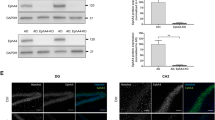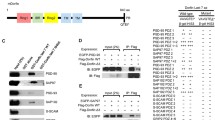Abstract
Passive avoidance (PA) conditioning is a fear motivated task able to initiate a cascade of altered gene expression within the hippocampus, a structure critical to learning and memory. We have previously shown that neurofibromin (NF1) and amyloid precursor protein (APP), two genes implicated in cognitive function, are differentially expressed in brain of dopamine D3 receptor knock-out mice (D3R−/−), suggesting that the receptor might have a role in their trascriptional regulation. Here in this study, we hypothesized that during acquisition of PA conditioning the expression of NF1 and APP genes could be influenced by D3Rs. To address this issue, we analyzed the expression of NF1 and APP in the hippocampus of both wild-type (WT) and D3R−/− mice subjected to the single trial step-through PA paradigm. Our finding demonstrated that (1) D3R−/− mice exhibit increased cognitive performance as compared to WT mice in the step-through PA trial; (2) acquisition of PA increased D3R and NF1, but not APP expression in WT mice hippocampus; (3) PA-driven NF1 induction in WT was abrogated in D3R−/− mice and finally that (4) the heightened basal APP expression observed in naive D3R−/− mice was totally reversed by acquisition of PA. In conclusion, the present finding show for the first time that both D3R and NF1 genes are upregulated following PA conditioning and suggest that hippocampal D3Rs might be relevant to NF1 transcriptional regulation in the hippocampus.





Similar content being viewed by others
References
Missale C, Nash SR, Robinson SW, Jaber M, Caron MG (1998) Dopamine receptors: from structure to function. Physiol Rev 78:189–225
Karasinska JM, George SR, Cheng R, O’Dowd BF (2005) Deletion of dopamine D1 and D3 receptors differentially affects spontaneous behaviour and cocaine-induced locomotor activity, reward and CREB phosphorylation. Eur J Neurosci 22:1741–1750. doi:10.1111/j.1460-9568.2005.04353
Sokoloff P, Giros B, Martres MP, Bouthenet ML, Schwartz JC (1990) Molecular cloning and characterization of a novel dopamine receptor (D3) as a target for neuroleptics. Nature 347:146–151. doi:10.1038/347146a0
Levant B (1998) Differential distribution of D dopamine receptors in the brains of several 3 mammalian species. Brain Res 800:269–274. doi:10.1016/S0006-8993(98)00529-0
Castorina A, Leggio GM, Giunta S, Magro G, Scapagnini G, Drago F, D’Agata V (2011) Neurofibromin and amyloid precursor protein expression in dopamine D3 receptor knock-out mice brains. Neurochem Res 36:426–434. doi:10.1007/s11064-010-0359-0
Kaasinen V, Vilkman H, Hietala J, Någren K, Helenius H, Olsson H, Farde L, Rinne J (2000) Age-related dopamine D2/D3 receptor loss in extrastriatal regions of the human brain. Neurobiol Aging 21:683–688. doi:10.1016/S0197-4580(00)00149-4
Kaasinen V, Kemppainen N, Någren K, Helenius H, Kurki T, Rinne JO (2002) Age-related loss of extrastriatal dopamine D(2)-like receptors in women. J Neurochem 81:1005–1010. doi:10.1046/j.1471-4159.2002.00895
Laszy J, Laszlovszky I, Gyertyán I (2005) Dopamine D3 receptor antagonists improve the learning performance in memory-impaired rats. Psychopharmacology 179:567–575. doi:10.1007/s00213-004-2096-z
Izquierdo I, Bevilaqua LR, Rossato JI, Bonini JS, Medina JH, Cammarota M (2006) Different molecular cascades in different sites of the brain control memory consolidation. Trends Neurosci 29:496–505. doi:10.1016/j.tins.2006.07.005
Micale V, Cristino L, Tamburella A, Petrosino S, Leggio GM, Di Marzo V, Drago F (2010) Enhanced cognitive performance of dopamine D3 receptor “knock-out” mice in the step-through passive-avoidance test: assessing the role of the endocannabinoid/endovanilloid systems. Pharmacol Res 61:531–536. doi:10.1016/j.phrs.2010.02.003
Gasbarri A, Sulli A, Innocenzi R, Pacitti C, Brioni JD (1996) Spatial memory impairment induced by lesion of the mesohippocampal dopaminergic system in the rat. Neuroscience 74:1037–1044. doi:10.1016/0306-4522(96)00202-3
Izquierdo LA, Barros DM, Ardenghi PG, Pereira P, Rodrigues C, Choi H, Medina JH, Izquierdo I (2000) Different hippocampal molecular requirements for short- and long-term retrieval of one-trial avoidance learning. Behav Brain Res 111:93–98. doi:10.1016/S0166-4328(00)00137-6
D’Agata V, Cavallaro S (2003) Hippocampal gene expression profile in passive avoidance conditioning. Eur J Neurosci 18:2835–2841. doi:10.1111/j.1460-9568.2003.03025
Costa RM, Federov NB, Kogan JH, Murphy GG, Stern J, Ohno M, Kucherlapati R, Jacks T, Silva AJ (2002) Mechanism for the learning deficits in a mouse model of neurofibromatosis type 1. Nature 415:526–530. doi:10.1038/nature711
Marcello E, Epis R, Di Luca M (2008) Amyloid flirting with synaptic failure: towards a comprehensive view of Alzheimer’s disease pathogenesis. Eur J Pharmacol 585:109–118. doi:10.1016/j.ejphar.2007.11.083
De Schepper S, Boucneau JM, Westbroek W, Mommaas M, Onderwater J, Messiaen L, Naeyaert JM, Lambert JL (2006) Neurofibromatosis type 1 protein and amyloid precursor protein interact in normal human melanocytes and colocalize with melanosomes. J Invest Dermatol 126:653–659. doi:10.1038/sj.jid.5700087
Guilding C, McNair K, Stone TW, Morris BJ (2007) Restored plasticity in a mouse model of neurofibromatosis type 1 via inhibition of hyperactive ERK and CREB. Eur J Neurosci 25:99–105. doi:10.1111/j.1460-9568.2006.05238.x
Selkoe DJ (2002) Deciphering the genesis and the fate of amyloid beta-protein yields novel therapies for Alzheimer disease. J Clin Invest 110:1375–1381. doi:10.1172/JCI0216783
Seabrook GR, Rosahl TW (1999) Transgenic animals relevant to Alzheimer’s disease. Neuropharmacology 38:1–17. doi:10.1016/S0028-3908(98)00170-1
Moran PM, Higgins LS, Cordell B, Moser PC (1995) Age-related learning deficits in transgenic mice expressing the 751-amino acid isoform of human 18-amyloid precursor protein. Proc Natl Acad Sci USA 92:5341–5345
Senechal Y, Kelly PH, Dev KK (2008) Amyloid precursor protein knockout mice show age-dependent deficits in passive avoidance learning. Behav Brain Res 186:126–132. doi:10.1016/j.bbr.2007.08.003
DeGiorgio LA, Shimizu Y, Chun HS, Kim YS, Sugama S, Son JH, Joh TH, Volpe BT (2002) Amyloid precursor protein gene disruption attenuates degeneration of substantia nigra compacta neurons following axotomy. Brain Res 938:38–44. doi:10.1016/S0006-8993(02)02483-6
Suh YH, Checler F (2002) Amyloid precursor protein, presenilins and alpha-synuclein: molecular pathogenesis and pharmacological applications in Alzheimer disease. Pharmacol Rev 54:469–525. doi:10.1124/pr.54.3.469
De Strooper B, Annaert W (2000) Proteolytic processing and cell biological functions of the amyloid precursor protein. J Cell Sci 113:1857–1870
De Strooper B, Annaert W (2000) Proteolytic processing and cell biological functions of the amyloid precursor protein. J Cell Sci 113:1857–1870
Dawson GR, Seabrook GR, Zheng H, Smith DW, Graham S, O’Dowd G, Bowery BJ, Boyce S, Trumbauer ME, Chen HY, Van der Ploeg LH, Sirinathsinghji DJ (1999) Age-related cognitive deficits, impaired long-term potentiation and reduction in synaptic marker density in mice lacking the β-amyloid precursor protein. Neuroscience 90:1–13. doi:10.1016/S0306-4522(98)00410-2
Conboy L, Murphy KJ, Regan CM (2005) Amyloid precursor protein expression in the rat hippocampal dentate gyrus modulates during memory consolidation. J Neurochem 95:1677–1688. doi:10.1111/j.1471-4159.2005.03484
Accili D, Fishburn CS, Drago J, Steiner H, Lachowicz JE, Park BH, Gauda EB, Lee EJ, Cool MH, Sibley DR, Gerfen CR, Westphal H, Fuchs S (1996) A targeted mutation of the D3 dopamine receptor gene is associated with hyperactivity in mice. Proc Natl Acad Sci USA 93:1945–1949
Venault P, Chapouthier G, de Carvalho LP, Simiand J, Morre M, Dodd RH, Rossier J (1986) Benzodiazepine impairs and beta-carboline enhances performance in learning and memory tasks. Nature 321:864–866. doi:10.1038/321864a0
Shirayama Y, Chen AC, Nakagawa S, Russell DS, Duman RS (2002) Brain-derived neurotrophic factor produces antidepressant effects in behavioral models of depression. J Neurosci 22:3251–3261
Schmittgen TD, Livak KJ (2008) Analyzing real-time PCR data by the comparative C(T) method. Nat Protoc 3:1101–1108
Glickstein SB, Desteno DA, Hof PR, Schmauss C (2005) Mice lacking dopamine D2 and D3 receptors exhibit differential activation of prefrontal cortical neurons during tasks requiring attention. Cereb Cortex 15:1016–1024. doi:10.1093/cercor/bhh202
Lacroix LP, Ceolin L, Zocchi A, Varnier G, Garzotti M, Curcuruto O, Heidbreder CA (2006) Selective dopamine D3 receptor antagonists enhance cortical acetylcholine levels measured with high-performance liquid chromatography/tandem mass spectrometry without anti-cholinesterases. J Neurosci Methods 157:25–31. doi:10.1016/j.jneumeth.2006.03.017
Millan MJ, Di Cara B, Dekeyne A, Panayi F, De Groote L, Sicard D, Cistarelli L, Billiras R, Gobert A (2007) Selective blockade of dopamine D(3) versus D(2) receptors enhances frontocortical cholinergic transmission and social memory in rats: a parallel neurochemical and behavioural analysis. J Neurochem 100:1047–1061. doi:10.1111/j.1471-4159.2006.04262
Collo G, Bono F, Cavalleri L, Plebani L, Merlo Pich E, Millan MJ, Spano PF, Missale C (2012) Pre-synaptic dopamine D(3) receptor mediates cocaine-induced structural plasticity in mesencephalic dopaminergic neurons via ERK and Akt pathways. J Neurochem 120:765–778. doi:10.1111/j.1471-4159.2011.07618
Donarum EA, Halperin RF, Stephan DA, Narayanan V (2006) Cognitive dysfunction in NF1 knock-out mice may result from altered vesicular trafficking of APP/DRD3 complex. BMC Neurosci. 7:22. doi:10.1186/1471-2202-7-22
Acknowledgments
These experiments were supported by the international PhD program in Neuropharmacology, University of Catania, Medical School. We thank Mr P. Asero for his technical support.
Author information
Authors and Affiliations
Corresponding author
Rights and permissions
About this article
Cite this article
D’Amico, A.G., Castorina, A., Leggio, G.M. et al. Hippocampal Neurofibromin and Amyloid Precursor Protein Expression in Dopamine D3 Receptor Knock-out Mice Following Passive Avoidance Conditioning. Neurochem Res 38, 564–572 (2013). https://doi.org/10.1007/s11064-012-0949-0
Received:
Revised:
Accepted:
Published:
Issue Date:
DOI: https://doi.org/10.1007/s11064-012-0949-0




